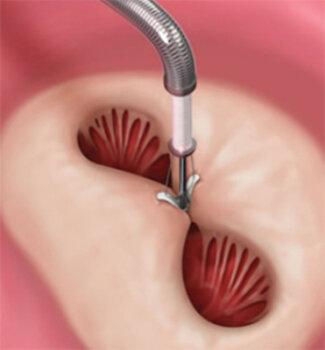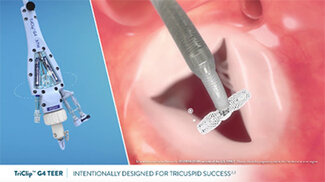Interventions of the mitral and tricuspid valve
Treatment using MitraClip/TriClip, Pascal or Tendyne
In recent years, various procedures have been clinically established for the treatment of mitral valve insufficiency. In the following, we would like to give you an overview of the invasive procedures available at our center for the treatment of mitral valve insufficiency.

© Abbott MitraClip™: Schematic Implantation of the MitraClip
Example MitraClip/Pascal
For patients discussed in a heart team and identified as having a high surgical risk due to severe comorbidities such as renal insufficiency or heart failure, a minimally invasive, catheter-based procedure like the MitraClip or Pascal technique may be considered.
In this procedure, the device, attached to a catheter, is advanced under general anesthesia into the left heart up to the mitral valve. By securing the device to the anterior and posterior mitral leaflets, a permanent connection is established, reducing mitral regurgitation. The procedure is performed without opening the chest and without using a heart-lung machine. Patients can usually get up the day after the procedure.

© Abbott TriClip™: Transcatheter Edge-to-Edge Repair (TEER)
Tricuspid Valve Regurgitation
Therapy using TriClip, Pascal, or TricValve
Tricuspid valve regurgitation can cause a variety of symptoms, including shortness of breath, leg swelling, as well as kidney and liver dysfunction. Patients with these conditions often face a high surgical risk, making minimally invasive procedures the only viable option. Similar systems to those used for the mitral valve can be utilized, with the device placed between the three leaflets of the tricuspid valve until sufficient reduction in regurgitation is achieved.
